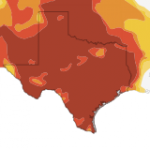El Niño Changed His Mind: Cooler, Wetter Winter No Longer Forecast

Photo by JOEL SAGET/AFP/Getty Images
New forecasts say there's lower odds of a wet, cool winter for Texas.
Texas really needs a wet winter. And until recently, the forecasts called for exactly that: an El Niño weather pattern in the Pacific was scheduled to appear, which typically results in cooler, wetter winters for the state. Now it looks like El Niño’s changed his mind, and the implications for an already-parched state are huge.
“El Nino would have given us our best shot at above-normal rainfall during the winter,” John Nielsen-Gammon, the state climatologist, says. “With much of the state having had two years-plus of drought, a nice wet winter would have been helpful in breaking it.”
But the forecasts aren’t always predictive of what will actually happen. Last winter, under La Niña conditions (which largely caused the drought of 2011 that still continues today), the state actually received above-average rainfall. Just not enough to bust the drought.

Photo courtesy of Texas A&M University
John Nielsen-Gammon, the state climatologist, says Texas is facing a 50-50 chance of being in another drought of record.
While Texas has had a good year of rain, the state remains in drought. Texas’ reservoirs are only 64 percent full overall, and some lakes are well below that mark, as you can see in this new interactive map from the Texas Water Development Board.
Without the appearance of El Niño, however, the odds decrease that we’ll get above-normal rain to bring those lakes and reservoirs back.
“We could certainly get good rain,” Nielsen-Gammon says. “This year the prospects are better than the previous two.” But the new, lower odds of that happening are worrisome.
“The first set of forecasts indicate an increasing chance of La Niña next winter, 2013-2014,” Nielsen-Gammon says. “So that’s not good news.”
A return of La Niña could be devastating, he says. “If we end up with a fourth dry year, things are going to be looking a lot like the drought of record in the 1950s, with multiple consecutive years that are near-normal or way below normal [for precipitation],” Nielsen-Gammon says.
Nielsen-Gammon puts the odds of that happening at close to 50-50. “It think it’s all going to depend upon whether we get a nice, wet winter and spring this year.”
And the odds of that happening? They’re about even for below-normal or above-normal precipitation this winter in Texas. We likely won’t know where things stand until May or June.

